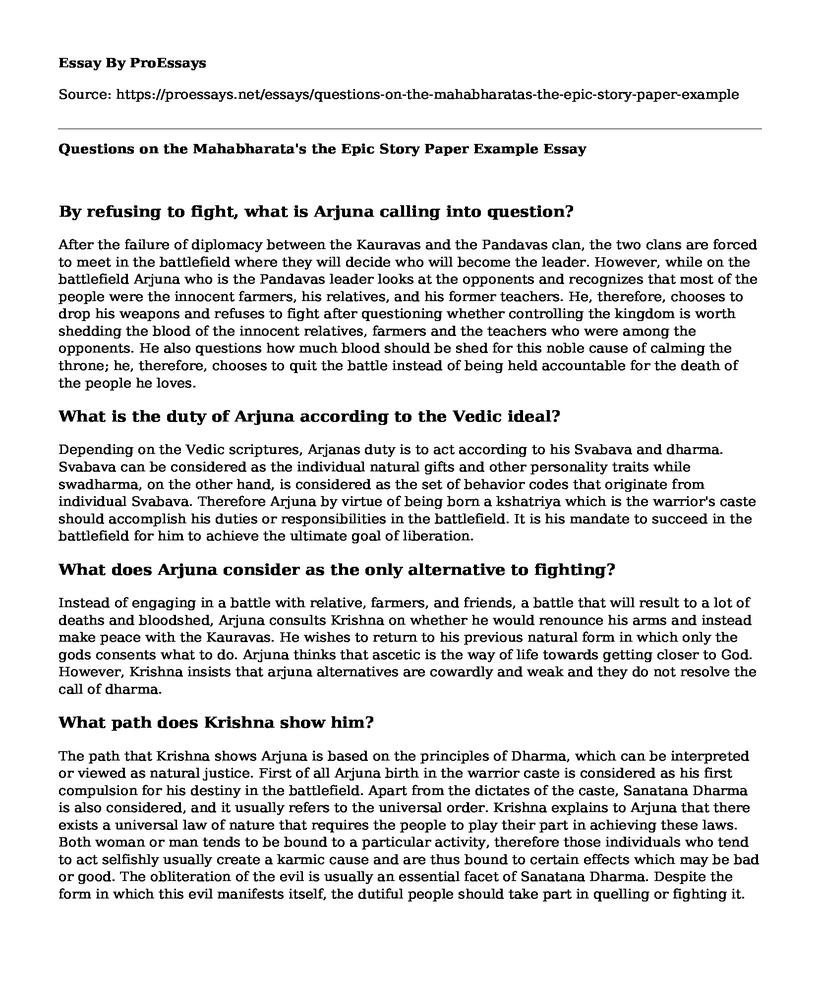By refusing to fight, what is Arjuna calling into question?
After the failure of diplomacy between the Kauravas and the Pandavas clan, the two clans are forced to meet in the battlefield where they will decide who will become the leader. However, while on the battlefield Arjuna who is the Pandavas leader looks at the opponents and recognizes that most of the people were the innocent farmers, his relatives, and his former teachers. He, therefore, chooses to drop his weapons and refuses to fight after questioning whether controlling the kingdom is worth shedding the blood of the innocent relatives, farmers and the teachers who were among the opponents. He also questions how much blood should be shed for this noble cause of calming the throne; he, therefore, chooses to quit the battle instead of being held accountable for the death of the people he loves.
What is the duty of Arjuna according to the Vedic ideal?
Depending on the Vedic scriptures, Arjanas duty is to act according to his Svabava and dharma. Svabava can be considered as the individual natural gifts and other personality traits while swadharma, on the other hand, is considered as the set of behavior codes that originate from individual Svabava. Therefore Arjuna by virtue of being born a kshatriya which is the warrior's caste should accomplish his duties or responsibilities in the battlefield. It is his mandate to succeed in the battlefield for him to achieve the ultimate goal of liberation.
What does Arjuna consider as the only alternative to fighting?
Instead of engaging in a battle with relative, farmers, and friends, a battle that will result to a lot of deaths and bloodshed, Arjuna consults Krishna on whether he would renounce his arms and instead make peace with the Kauravas. He wishes to return to his previous natural form in which only the gods consents what to do. Arjuna thinks that ascetic is the way of life towards getting closer to God. However, Krishna insists that arjuna alternatives are cowardly and weak and they do not resolve the call of dharma.
What path does Krishna show him?
The path that Krishna shows Arjuna is based on the principles of Dharma, which can be interpreted or viewed as natural justice. First of all Arjuna birth in the warrior caste is considered as his first compulsion for his destiny in the battlefield. Apart from the dictates of the caste, Sanatana Dharma is also considered, and it usually refers to the universal order. Krishna explains to Arjuna that there exists a universal law of nature that requires the people to play their part in achieving these laws. Both woman or man tends to be bound to a particular activity, therefore those individuals who tend to act selfishly usually create a karmic cause and are thus bound to certain effects which may be bad or good. The obliteration of the evil is usually an essential facet of Sanatana Dharma. Despite the form in which this evil manifests itself, the dutiful people should take part in quelling or fighting it.
What does Krishna put forth as the key to liberation from rebirth?
According to Krishna, to achieve liberation from birth, one needs to merge Jeevatma, which is considered as the substance of individual soul with the Paramatma, which is considered as the spirit of the entire cosmos. The mission can however not be achieved using only the esoteric practices of asceticism. Another thing that is important for one to achieve liberation by birth is completing the personal duties towards yourself and the entire community. This rules of achieving liberation by birth are indicated in the yogic texts which are under the karma yoga and act as the motivation towards moksha or liberation by birth through taking part I the worldly deeds or actions. Krishna, therefore, explains to Arjuna how the battlefield can act as the arena or field for self-emancipation.
How does Krishna uphold the Vedic view of supporting the world while also accommodating the world-denying view?
Krishna tries to prove to Arjuna that the dualistic and monistic perspectives of the world are usually not incompatible. Krishna explains to Arjuna the various ways in which the noble worldly deeds help a person to achieve the cosmic assimilation. Krishna, therefore, tries to invoke the belief of Suguna Brahman by encouraging Arjuna to unit his devotion, wisdom and his desire to achieve liberation from other earthly existence. Based on this view, even the dullest activities can help to achieve liberation if they are done in the right spirit or motivation. Therefore there is no need for Arjuna to reject all the things that are attached to the world. Since such behavior would prevent him from fulfilling his dharma obligation. Krishna also tells Arjuna to consider Kurukshetra as a metaphor for the moral struggle that depends on spiritual growth or progress. Therefore any barbaric or evil actions that can happen or be witnessed in the battlefield have an opportunity to be trapped and directed towards spiritual awareness.
Cite this page
Questions on the Mahabharata's the Epic Story Paper Example. (2022, Nov 07). Retrieved from https://proessays.net/essays/questions-on-the-mahabharatas-the-epic-story-paper-example
If you are the original author of this essay and no longer wish to have it published on the ProEssays website, please click below to request its removal:
- The Hound of the Baskervilles by Sir Arthur Conan Doyle
- Literature Essay on the Canterbury Tales Prologue as an Introduction
- Formalist Analysis of Dry September By Faulkner William
- Gorge Orwell's 1984 and Language Essay
- Literary Analysis Essay on The E-Myth
- Ideas on Behaviour of Fish in an Egyptian Tea Garden Essay
- Essay Sample on Poetry: A Powerful Tool for Communicating Ideas & Attitudes







